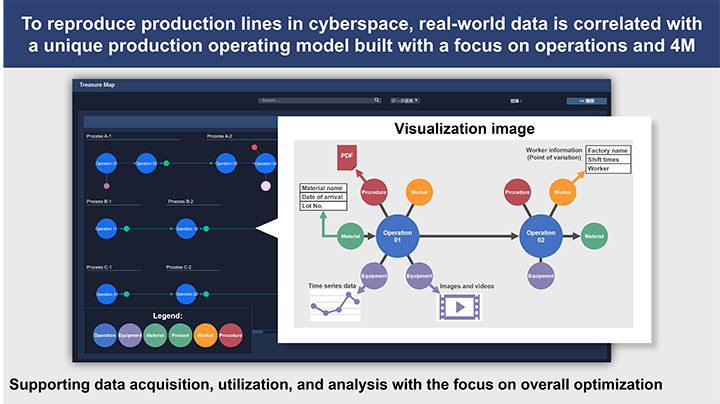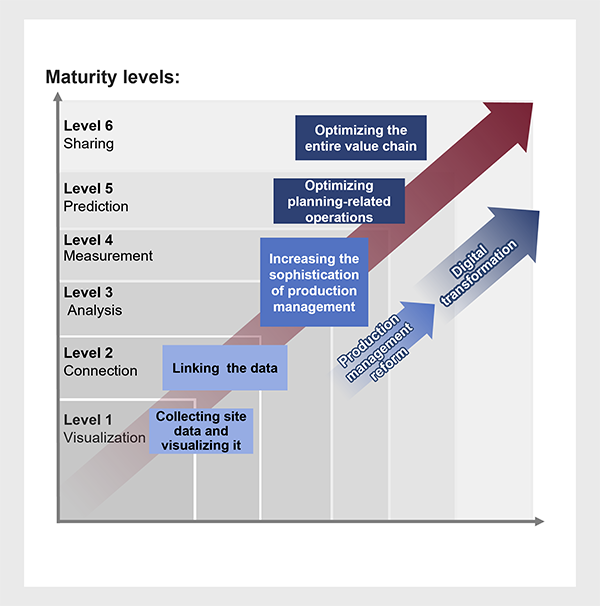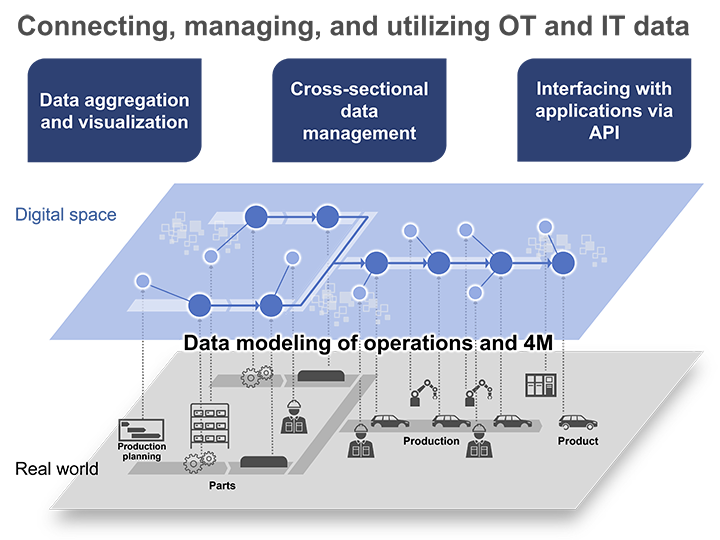Featured customer case
Lumada customer case code: UC-01948S
Hitachi’s digital twin solution for production sites
2023-03-02

In the manufacturing industry, operational improvements have made production more efficient. However, even though manufacturers know that data collected from production sites contains information that can improve operations, the data is still not being used effectively.
This article describes how collecting, formatting, correlating, and using disparate sources of OT (operational technologies) and IT (information technologies) data from a production site can improve and optimize the entire manufacturing process. In addition, the article introduces a customer case in which the customer reaped the benefits of applying this solution.
In addition to improving operational efficiency and productivity, you can use data obtained from the factory floor to respond to trends, such as addressing the diversifying needs of consumers through high-mix, low-volume production. Furthermore, you can use the data to optimize your entire supply chain from mid- to long-term perspectives.
In addition, using AI in the processing and analysis of collected data can provide solutions to social issues such as the ongoing worker shortages brought about by aging demographics.
Co-creation with Lumada! Making factories smarter by introducing IoT infrastructure
To achieve their goals of improving quality and productivity, reducing costs, compensating for worker shortages, and developing human resources, manufacturers are striving to utilize data to make factories smarter.
Factories perform spot checks to ensure product quality. If a defective sample is found, the extent of the impact is identified based on the sample’s manufacturing history and from data such as the results of inspections of the defective sample and other samples.
Product defects can be the result of issues across multiple processes. If the cause of the defect does not lie in the process in which the defect was detected, the scope of the investigation has to be expanded to the entire factory. For example, the investigation needs to extract and analyze data on the state of the equipment in use, the product quality, and production plans.
In the past, such investigations faced a key problem: equipment operational data is usually stored separately for each process, and the data for independently built operational systems is collected at different times and in different formats. Identifying the scope of impact from clues present in such data requires a high level of expertise to prevent slight changes in the data from being overlooked. In the past, only a select few individuals were capable of performing this type of work. It also took time to narrow down the products that need to be investigated and to identify what caused the defect to occur.

Collecting, formatting, and correlating a broad range of disparate data from each factory process makes it possible to find differences between normal samples and defective samples. Identifying which products were produced under the same conditions as the defective sample allows users to pinpoint the scope and targets of the quality inspection, thereby improving the efficiency of the inspection process. These measures deliver the following benefits:
Further, the ability to trace data back from the point where a variation occurred enables manufacturers to identify the processes where a defect occurred and to understand whether there was a problem in the materials, equipment, or work methods that were used. In this way, manufacturers can use the data to analyze the causes of defects and to take countermeasures.
The introduction of digital twin technology*1 to manufacturing sites allows manufacturers to use real-world data to create virtual reproductions of production lines. This helps identify the causes of any problems that arise, and enables the manufacturers to review and conduct trials of potential operational improvements. By visualizing a production line across processes, manufacturers can confirm how an event occurring in a certain process affects other processes. This makes it easier to identify potential areas of improvement and to deliver optimization across the entire production process.
To reproduce production lines in cyberspace, Hitachi’s digital twin solution for production sites aggregates OT and IT data collected and maintained by individual processes and correlates this real-world data with a unique production operating model built with a focus on operations and 4M*2. This approach supports data acquisition, utilization, and analysis from the perspective of total optimization. This solution can collect and maintain data without requiring users to have expertise in the various production operations or data.


Hitachi clarifies a six-tiered approach toward improving production management systems, implementing DX-driven aids according to the objectives of the production site and the level being aimed for.
Hitachi’s digital twin solution for production sites is fit for use in factories striving to achieve up to maturity level 6 across each phase of production. Hitachi prepares an array of solutions suitable for each level and provides total smart factory support.
Connecting OT and IT data existing in multiple sites
Data on equipment operational status and quality information (OT data) and production plans and inventory management information (IT data) is often located across multiple production sites. Hitachi’s digital twin solution for production sites correlates such data as digital data, facilitating its use in optimizing the entire production business.

Using a unique approach, Hitachi’s digital twin solution for production sites provides integrated management of the connections between data existing in different production processes and the OT and IT data generated from the operations. With a focus on the worksite, Hitachi’s digital twin solution for production sites helps to improve and optimize the entirety of production.
The following section showcases an example of a factory that achieved a high level of traceability, streamlined the use of human resources, and enhanced management through the aggregation and visualization of OT and IT data.
A manufacturer was considering ways to further data utilization in order to establish its facilities as a next-generation smart factory. Hitachi’s digital twin solution for production sites was introduced to a highly automated production line to reduce production issues, and to improve production efficiency and competitiveness. The solution aggregated and visualized a broad range of data spanning the equipment, devices, and IT systems in use across the entire factory. As a result, the following three benefits were achieved:
In addition, rolling out the IoT infrastructure to a second or third factory provides greater scope for data connectivity. The aggregation and use of data from product distribution and the supply chain, in addition to data from the factory floor, facilitates operational improvements over a broader area.
For details on our solutions, see the following webpages.
In addition to improving operational efficiency and productivity, you can use data obtained from the factory floor to respond to trends, such as addressing the diversifying needs of consumers through high-mix, low-volume production. Furthermore, you can use the data to optimize your entire supply chain from mid- to long-term perspectives.
In addition, using AI in the processing and analysis of collected data can provide solutions to social issues such as the ongoing worker shortages brought about by aging demographics.